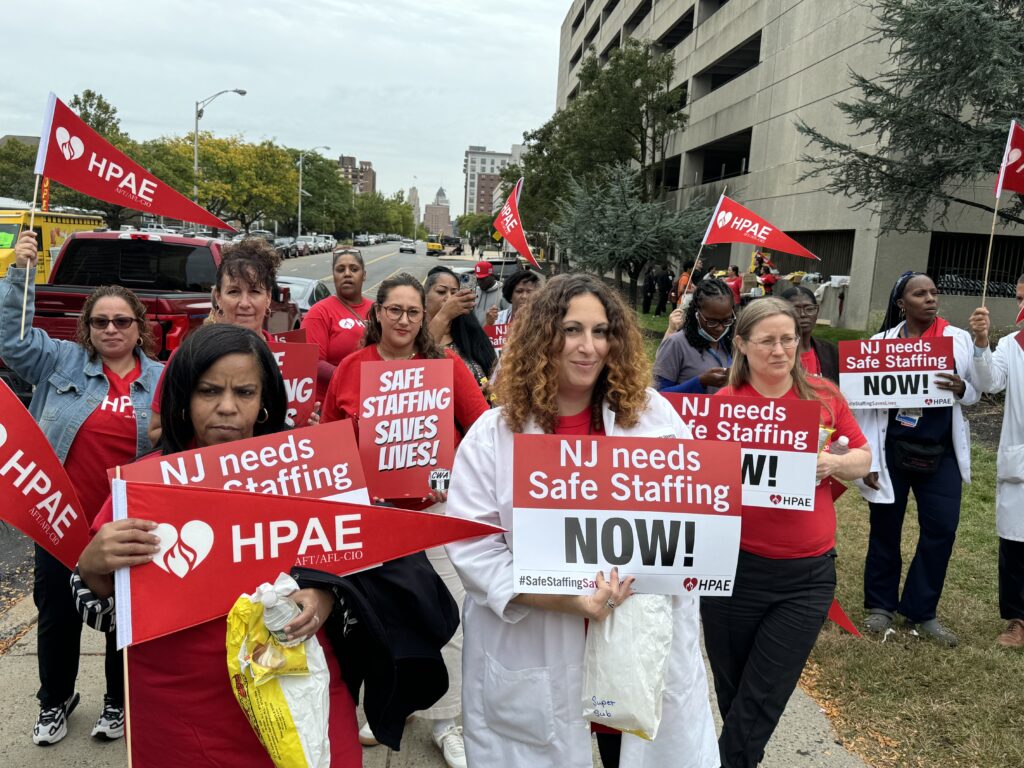Members of Health Professionals and Allied Employees protest outside University Hospital in Newark on Sept. 18, 2024. (Photo by Mark J. Bonamo)
Ten days before a contract between University Hospital in Newark and its nurses is set to expire, the two sides remain at odds mostly over one issue that has had a serious impact on hospitals and their nurses nationwide: patient-to-worker ratios.
Among the demands of the Health Professionals and Allied Employees Local 5089 is the establishment of a 5:1 patient-to-worker ratio, a ratio that union leaders argue will help the hospital recruit and retain nurses and other health care workers. According to the union, New Jersey has about 146,000 nurses licensed in the state, but only about 78,000 nurses are willing to work, with an even smaller percentage of that number working in hospitals.
Burnout, which intensified during the pandemic, is a lingering problem as job stress remains heightened because of short staffing, they say.
“Fifteen nurses to one patient is not enough. Twenty nurses to one patient is not enough. That’s not an option,” said Banita Herndon, a 23-year veteran emergency room nurse at University Hospital and president of the local. “We need enough nurses to provide the highest quality of care for our patients.”
Herndon spoke Wednesday to a crowd of about 50 gathered outside University Hospital to call for “safe staffing.”
The clash comes a year after a contract fight between Robert Wood Johnson University Hospital and its nurses union led 1,700 nurses to go on strike for four months. The nurses there were also pushing for better patient-to-worker ratios to help address what they described as unsafe staffing levels, as well as for higher wages.
Nurses say reducing the number of patients assigned to them results in improved outcomes for patients, including fewer deaths, reduced workplace injuries, better retention of staff, and cost savings for hospitals.
Union leaders point to proposed state legislation as a potential solution. Dubbed the Patient Protection and Safe Staffing Act, the bill was introduced in February by Sen. Joseph Vitale (D-Middlesex) and Assemblywoman Annette Quijano (D-Union) and would set enforceable patient-to-worker ratios, depending on the type of care. Under the bill, hospitals would be required to have one registered nurse for every four patients in a medical/surgical unit or in an emergency room, and one nurse for every two patients in a critical care, intensive care, neonatal, or burn unit.
There is some precedent nationally for mandated patient-to-staff ratios. California became the first in the nation to enact them in 2004. Oregon’s governor signed a bill mandating these ratios last year.
Health Professionals and Allied Employees has negotiated staffing ratios in three new contracts with Palisades Medical Center, Englewood Health and Cooper University Medical Center in Camden this year that union leaders say protect patients and respect health care workers.
“Ratios save lives. Cooper University Hospital, which is a Level 1 trauma center just like University Hospital in Newark, negotiated 4:1 and 5:1 ratios, and they now use that to attract staff,” Debbie White, president of Health Professionals and Allied Employees, said Wednesday. “It’s a retention issue. The No. 1 reason nurses are leaving hospitals is unsafe staffing. Wages will recruit people. Safe staffing will retain them. Again, safe staffing saves lives.”
Samantha Lish, spokesperson for University Hospital, said the hospital is “committed to working collaboratively with HPAE to address their members’ concerns” and is “at the forefront of safe staffing in New Jersey.”
“The Hospital remains not only in compliance with all state regulations regarding nurse-to-patient staffing ratios, but consistently exceeds those requirements,” Lish said, adding that the hospital was “one of the first hospitals in the State to include staffing guidelines within its own contract. We have also made tremendous strides in reducing our nurse vacancy rate, succeeding in hiring over 170 staff nurses in the past year to reduce our vacancy rate to single digits.”
White said better wages are another protest focus.
“Wages are not just a number on a paycheck. Wages are a reflection of how much workers are valued,” White said. “What happens when workers are not valued? They leave.”
Herndon continues to love her nursing job but said serious on-the-job challenges still need to be addressed in any new contract with the hospital.
“The most important thing is to get safe patient ratios so we can give the best quality care, but also have a good work-life balance,” Herndon said. “We don’t want to cut corners. I need to be taking care of you.”
GET THE MORNING HEADLINES DELIVERED TO YOUR INBOX

